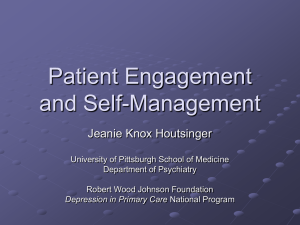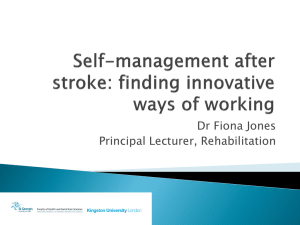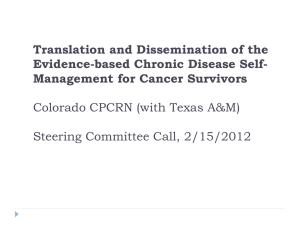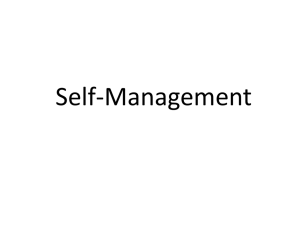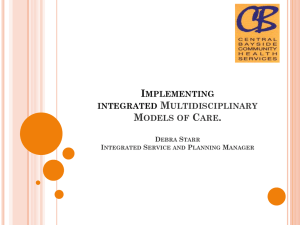Implementing Self Management Support: A Tool Kit for Clinicians
advertisement
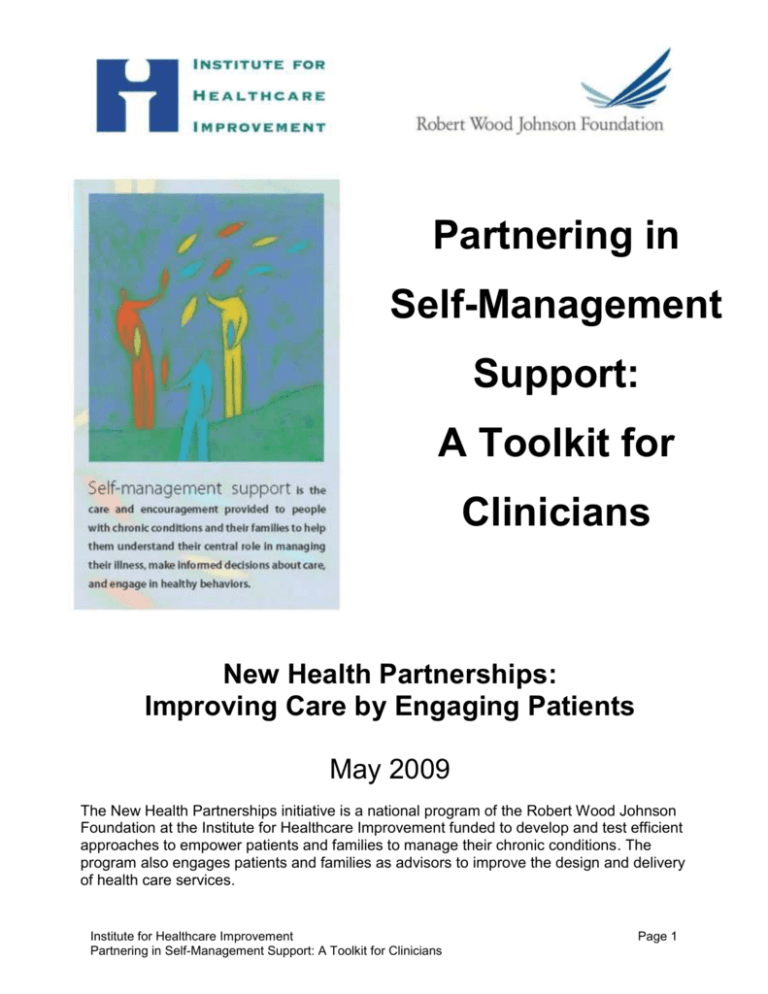
Partnering in Self-Management Support: A Toolkit for Clinicians New Health Partnerships: Improving Care by Engaging Patients May 2009 The New Health Partnerships initiative is a national program of the Robert Wood Johnson Foundation at the Institute for Healthcare Improvement funded to develop and test efficient approaches to empower patients and families to manage their chronic conditions. The program also engages patients and families as advisors to improve the design and delivery of health care services. Institute for Healthcare Improvement Partnering in Self-Management Support: A Toolkit for Clinicians Page 1 Contents Introduction ................................................................................................................... 3 Collaborative Care: Cycle of Self-Management Support ........................................... 9 Building Relationships ............................................................................................... 10 Gathering Clinical and Patient Experience Data ...................................................... 12 Provider Exam ............................................................................................................. 14 Team Care: Nurse and Medical Assistant Coaching and Support .......................... 17 Providing Ongoing Follow-Up .................................................................................... 19 Sustaining Self-Management Support: Training for Practice Teams ..................... 20 Sustaining Self-Management Support: Community Partnerships .......................... 21 Sustaining Self-Management Support: Partnering with Patients and Families ..... 22 Sustaining Self-Management Support: The Chronic Care Model ........................... 23 Institute for Healthcare Improvement Partnering in Self-Management Support: A Toolkit for Clinicians Page 2 “Self-management support is the assistance caregivers give to patients with chronic disease in order to encourage daily decisions that improve health-related behaviors and clinical outcomes. Self-management support may be viewed in two ways: as a portfolio of techniques and tools that help patients choose healthy behaviors; and as a fundamental transformation of the patient-caregiver relationship into a collaborative partnership... The purpose of self-management support is to aid and inspire patients to become informed about their conditions and take an active role in their treatment.” Tom Bodenheimer, Helping Patients Manage Their Chronic Conditions www.chcf.org, 2005 Introduction Helping patients and families manage chronic conditions is an idea whose time has come. Self-management support is a central focus in the Institute of Medicine Crossing the Quality Chasm report and the patient-centered medical home, and is receiving increasing attention in the continuing education programs of professional organizations, with good reason. Many patients do not understand what their doctors have told them and do not participate in decisions about their care, which leaves them ill prepared to make daily decisions and take actions that lead to good management. Others are not yet even aware that taking an active role in managing their condition can have a big impact on how they feel and what they are able to do. Enabling patients to make good choices and sustain healthy behaviors requires a collaborative relationship, a new health partnership between health care providers and teams, and patients and their families; a partnership that supports patients in building the skills and confidence they need to lead active and fulfilling lives. The concepts and tools in this toolkit are intended to give busy clinical practices an introduction to a set of activities and changes that support patients and families in the day-to-day management of chronic conditions. Experienced organizations and teams will find tested resources and tools. Practices that are just beginning to reorganize for patient-centered care as well as those experienced in collaborative self-management will find tested resources and tools and high-leverage changes that offer a number of ways to begin trying them with a small number of patients. Where do I begin? Finding the time and learning the skills to partner with patients to support healthy behaviors is challenging given the demands on primary care today. But you can use the same skills and tools to change your practice as patients use to change health behaviors. Start small, choose one skill or process to change, try it with just a few patients, and then assess your experience. Engage others in your practice to take a role. Together, you can problem-solve the issues that arise and build on your successes. Below are a few examples of ways to begin. Institute for Healthcare Improvement Partnering in Self-Management Support: A Toolkit for Clinicians Page 3 Build a shared agenda: Choose one of the agenda-setting tools in this toolkit and use it with five patients. Did using it help to make the conversation more collaborative? Did it give you more information about each patient’s concerns? Mail or link patients to one of the Visit Preparation Forms (see the section on Building Relationships below) to five patients before their scheduled visit. Did the patients have more questions? Was the conversation during the visit more productive? Provide clear information: After providing information about treatment or medication, use the “Closing the Loop” technique (see the section on Provider Exam below) with five patients. Did patients have more questions? Set goals and make action plans: Ask five patients what they would most like to work on to improve their health. Note the goal in their chart, and then ask them to meet with a nurse or medical assistant to complete an Action Plan (see the section on Team Care below). Follow up on their next visit to see how they did. Choose a “population of focus” such as patients with diabetes with whom to test changes: Identify diabetes patients who have upcoming visits scheduled by reviewing the next day’s appointments. Choose one of the tools in this toolkit (e.g., the Action Plan form or other goal-setting tools) to test with this patient population. Place a copy of the tool in the chart in advance of the visit to remind the care team to review the tool with the patient. Engage other members of the care team: Discuss the changes you are testing with the entire practice team. Are there ways that they can help prepare or complete some of the tasks so the visit goes smoothly? Assign roles and tasks to each team member to enhance each patient’s care experience. Ask patients how they feel about the changes to the visit that you are testing? Getting their feedback early in your change process will help you become more effective. Finally, there are a growing number of practitioners and teams experienced in selfmanagement support; their stories and examples are available on NewHealthPartnerships.org. You and your care team probably know more than you realize about supporting patients in self-management. As you dive deeper into partnering with patients and families, the links and tools in this toolkit will help you meet their self-management support needs. Institute for Healthcare Improvement Partnering in Self-Management Support: A Toolkit for Clinicians Page 4 Evidence for Self-Management Support Patient-centered self-management support improves health and physical function outcomes as well as patient satisfaction regarding care and can be accomplished with existing staffing models. Our confidence in these techniques and tools comes from the growing number of studies and reviews that provide evidence that helping patients and families manage chronic conditions improves outcomes. The tools and examples come from the experience of teams implementing self-management support in 35 health care systems in New Health Partnerships: Improving Care by Engaging Patients, a Robert Wood Johnson national program located at the Institute for Healthcare Improvement. The following papers provide evidence for the concepts and tools in this toolkit, but do not comprise a formal or comprehensive review of the literature. Bodenheimer T, Lorig K, Holman H, Grumbach K. Patient self-management of chronic disease in primary care. JAMA. 2002 Nov 20;288(19):2469-2475. Evidence from controlled clinical trials suggests that programs teaching selfmanagement support are more effective than information-only patient education in improving clinical outcomes, and self-management education improves outcomes and can reduce costs. Bodenheimer T, Laing BY. The teamlet model of primary care. Ann Fam Med. 2007 Sep-Oct;5(5):457-461. The 15-minute visit does not allow the physician sufficient time to provide the variety of services expected of primary care. A teamlet (little team) model of care is proposed to extend the 15-minute physician visit. Brownson CA, Miller D, Crespo R, et al. A quality improvement tool to assess selfmanagement support in primary care. Jt Comm J Qual Patient Saf. 2007 Jul;33(7):408-416. The Assessment of Primary Care Resources and Supports (PCRS) for Chronic Disease Self-Management is a tool designed to apply to a variety of primary care settings and across different chronic illnesses. It helps practices self-evaluate their current delivery of resources and supports for self-management and identify areas and ways in which they could enhance these services. Glasgow RE, Funnell MM, Bonomi AE, Davis C, Beckham V, Wagner EH. Selfmanagement aspects of the improving chronic illness care breakthrough series: Implementation with diabetes and heart failure teams. Ann Behav Med. 2002 Spring;24(2):80-87. Implementing self-management support in the context of the Chronic Care Model improves care for both diabetes and heart failure patients. Heisler M. Building Peer Support Programs to Manage Chronic Disease: Seven Models for Success. California Health Care Foundation; December 2006. Available at: http://www.chcf.org/topics/chronicdisease/index.cfm?itemID=127997. Peer support interventions have been found to reduce problematic health behaviors and depression, and they help patients follow their medication prescriptions and adhere to diet and exercise plans. Institute for Healthcare Improvement Partnering in Self-Management Support: A Toolkit for Clinicians Page 5 Lewin SA, Skea ZC, Entwistle V, Zwarenstein M, Dick J. Interventions for providers to promote a patient-centred approach in clinical consultations. Cochrane Database Syst Rev. 2001;(4):CD003267. Actively involving patients and family members in self-management support improves treatment adherence and leads to better physical functioning. Lorig K, Feigenbaum P, Regan C, Ung E, Chastain RL, Holman HR. A comparison of lay-taught and professional-taught arthritis self-management courses. J Rheumatol. 1986 Aug;13(4):763-767. Lay leaders can teach self-management courses with results similar to those taught by professionals. Lorig KR, Sobel DS, Stewart AL, et al. Evidence suggesting that a chronic disease self-management program can improve health status while reducing hospitalization: A randomized trial. Med Care. 1999 Jan;37(1):5-14. Lay led self-management courses with participants who have diverse chronic conditions can be as effective as those for participants with arthritis alone. Norris SL, Lau J, Smith SJ, Schmid CH, Engelgau MM. Self-management education for adults with type 2 diabetes: A meta-analysis of the effect on glycemic control. Diabetes Care. 2002 Jul;25(7):1159-1171. Self-management education improves HbA1c levels at immediate follow-up and increased contact time increases the effect, although effects fade over time. Renders CM, Valk GD, Griffin S, Wagner EH, Eijk JT, Assendelft WJ. Interventions to improve the management of diabetes mellitus in primary care, outpatient, and community settings. Cochrane Database Syst Rev. 2001;1:CD001481. In multifaceted interventions to improve chronic care, the addition of patient-oriented interventions, self-management education, and self-management support to professional and/or organizational interventions has been shown to be key to improvements in patient outcomes rather than improvements in process outcomes alone. Schillinger D, Piette J, Grumbach K, et al. Closing the loop: Physician communication with diabetic patients who have low health literacy. Arch Intern Med. 2003 Jan 13;163(1):83-90. Many patients do not understand what their doctors have told them and benefit from specific techniques that help them leave the visit prepared to manage their health. Schoen C, Osborn R, Huynh PT, et al. Primary care and health system performance: Adults' experiences in five countries. Health Aff (Millwood). 2004 Jul-Dec;Suppl Web Exclusives:W4-487-503. Many patients do not feel included in decisions about their care. Simmons L, Baker NJ, Schaefer J, Miller D, Anders S. Activation of patients for successful self-management. J Ambul Care Manage. 2009 Jan-Mar;32(1):16-23. Whether the care team consists of a solo physician or a large, multi-physician organization, applying basic communications principles and using simple tools can enable patients to take a more active role in improving their health. Institute for Healthcare Improvement Partnering in Self-Management Support: A Toolkit for Clinicians Page 6 Suchman AL, Roter D, Green M, Lipkin M Jr. Physician satisfaction with primary care office visits. Collaborative Study Group of the American Academy on Physician and Patient. Med Care. 1993 Dec;31(12):1083-1092. Better communication with patients and families helps clinicians and health care organizations improve patient and staff satisfaction and staff retention. Institute for Healthcare Improvement Partnering in Self-Management Support: A Toolkit for Clinicians Page 7 Before, During, and After the Visit Help patients understand their central role in managing their conditions and that the entire health care team is there to help. High Impact Changes for SelfManagement Before the Visit During the Visit Skills and tools to transform the patient/caregiver relationship into a collaborative partnership Make time for self-management by gathering clinical and patient experience data in the chart. Ask patients to bring questions and concerns and health monitoring information. Collaboratively develop a visit agenda with the patient and family, handling as many concerns as possible, and plan return visits as appropriate. Engage the entire practice team in supporting patients, use “warm handoff” introductions, and explain team member roles to patients. Ask about patient goals to improve their health and help them make action plans that build confidence in their ability to reach these goals. Use “ask-tell-ask” to provide just the right information at just the right time and “close the loop” to ensure patients know how to use the information. Prepare a written care plan or visit summary that includes goals and action plans to ensure patients and families know what to do when they leave the visit. Use group medical appointments, peer-led support groups, or patient education classes to provide opportunities for patients to share experiences and support. After the Visit Organize follow-up support to help patients sustain healthy behaviors between visits. Extend care into the community by linking patients to community programs. Build a Team Designate and train a lead coach for selfmanagement support who will support ongoing staff development of skills. Assign responsibility for self-management tasks to all team members, extending the work out from the physician. Use daily team huddles to review the schedule of patient charts, anticipate care needs, and enhance the flow of care. Institute for Healthcare Improvement Partnering in Self-Management Support: A Toolkit for Clinicians Page 8 Collaborative Care: Cycle of Self-Management Support Institute for Healthcare Improvement Partnering in Self-Management Support: A Toolkit for Clinicians Page 9 Before, During, and After the Visit Building Relationships Team Support Managing one or more chronic conditions is ongoing hard work. One very basic support that practice teams can provide to patients and families is to acknowledge the work patients and families do to manage illness and recognize their central role in staying healthy. Every practice team member can support patients in this way. Physicians can help patients and family members understand that providers and practice staff work together as a team by introducing team members and explaining their roles, either in person or with a letter. Provide a “warm handoff” by introducing key team members in person and explaining the special role that a nurse or medical assistant plays. This increases patient confidence that the whole team is there to help and engenders trust. With training, all care team members can take a role in supporting patients, for example, greeting patients with a visit preparation form (see Bubble Diagram, Dinner Plate Menus, Doc Talk Form, How’s Your Health link, or Ask Me 3 below) that asks about progress with self-management tasks, and providing self-management information and skills training to patients. Coping with Stress and Negative Emotions Clinicians are rightfully focused on the clinical indicators and outcomes of chronic illness care, but for patients and families the central experience of chronic illness is often one of physical limitation, loss of function, and uncertainty in daily life. The fatigue and stresses of the disease and adapting life roles to accommodate changing capacities generate emotional responses that make a huge impact on the ability to self-manage. When clinical teams recognize this difference of perspective and acknowledge the everyday burden of illness and negative emotions (anger, fear, frustration) that so often accompany managing chronic diseases, patients and families feel heard and understood and are more willing to collaborate with clinical teams. You might say: o “Most of my patients who have chronic conditions have trouble at times coping with the changes and difficulties in managing their condition. How are you feeling about your (diabetes) and taking care of yourself?” Over time, these interactions support the collaborative relationship that helps patients become more active managers of their health and keeps them going during challenging times. Sometimes the psychosocial burdens require help from behavioral health specialists. Care visits that regularly utilize depression screening questions such as the Patient Health Questionnaire 2 can ensure that those who need more intensive help will be identified. Institute for Healthcare Improvement Partnering in Self-Management Support: A Toolkit for Clinicians Page 10 Key Change Acknowledge the patient’s role Key Reference or Tool Setting the Stage for Self-Management Support (presentation) Involve family members Institute for Family-Centered Care National Family Caregivers Association Family Caregiver Support Network Family Voices Ask about preferences, experience Bubble Diagram (Visit Preparation Form) Dinner Plate Menus (Visit Preparation Form) DocTalk Form (Visit Preparation Form) How’s Your Health (Visit Preparation Link) Help patients know what to expect Cambridge Health Alliance: Take Charge Poster California HealthCare Foundation: Helping Patients Manage Provide support for stress and negative emotions Dealing with Pain and Fatigue Stress Reduction Institute for Healthcare Improvement Partnering in Self-Management Support: A Toolkit for Clinicians Page 11 Before the Visit Gathering Clinical and Patient Experience Data Physicians rarely have time in a visit to adequately support patients in managing chronic conditions. Designate a member of the care team to gather both clinical and patient experience information in advance of the visit. Having all information readily available in the patient chart frees up time for the clinician and patient to communicate about issues of concern to each. Visit time can then be spent on recommendations about treatment and collaborating to develop a care plan to help the patient and family members manage better at home. Consider the flow of a planned care visit and the staff available in your practice, and determine tasks for each member of the care team. With standing orders, medical assistants can prepare for the visit by arranging for screenings and labs to be done in advance and ensuring that this information is readily available in the chart. Receptionists can help the patient prepare in advance for the visit by mailing a Visit Preparation Form, asking them to bring medications or records of medication use to the visit, and asking them to make a note of successes and problems they had in achieving their health improvement goals and action plans. Because depression is such a common co-morbidity in people with chronic conditions, you may also wish to include depression screening questions in the Visit Preparation Form. Beyond Ask Me 3 provides examples of additional questions useful in serving patients with chronic conditions. Having current information, both clinical indicators and patient concerns, prepared in advance provides the clinician with more time to address clinical concerns and the patient’s own goals, and the time to build a collaborative relationship that supports selfmanagement. Care teams often find it useful to hold a brief “huddle” at the beginning of the day to review the patient schedule and prepare for each patient’s visit. Institute for Healthcare Improvement Partnering in Self-Management Support: A Toolkit for Clinicians Page 12 Key Change Engage the whole practice team Key Reference or Tool Self-Management Support Roles and Tasks in Team Care Screen for depression The MacArthur Foundation Initiative on Depression and Primary Care: Depression Management Tool Kit IMPACT: Evidence-Based Depression Care Create efficient care St. Peter’s Family Medicine: Standing Order Form Palo Alto Medical Foundation: Planned Care Visit Workflow The Partnership for Healthcare Excellence Help patients prepare for the visit National Patient Safety Foundation: Ask Me 3 (Visit Preparation Form) Beyond Ask Me 3 DocTalk Form (Visit Preparation Form) How’s Your Health (Visit Preparation Link) Use planned care A Planned Care Visit Series Planned Care Huddle (video) Institute for Healthcare Improvement Partnering in Self-Management Support: A Toolkit for Clinicians Page 13 During the Visit Provider Exam Sharing Information One of the most important roles of clinicians is to provide information, including answering patients’ questions about a disease or its symptoms, interpreting clinical data or lab results, and explaining the appropriate use and methods for taking medication. Information about the illness, symptoms, treatment, and medications is central to patients’ ability to manage well, but information alone is not enough. The goal in sharing information for self-management support is to ensure that patients not only understand but are also prepared to act on the information in daily life. Of course, telling patients what they need to know is not a guarantee that they will be able to use the information, and conveying all critical information during a short visit may not have the desired outcome if patients are not able to understand and use it. Try the following techniques: Share clinical information based on patients’ lab or other screening values and interpret that information to connect their understanding of how healthy behaviors keep clinical indicators in range. You might say: o “What do you think is going on?” o “What is your understanding of this (condition, issue)? o “What worries you the most?” o “What else are you concerned about?” o “What do you know about (treatment, self-management)? Use the “Ask-Tell-Ask” technique to assess patients’ information needs and provide precise, tailored information they can use. First, Ask for Permission – You might say: o “Is it ok if I share some information about the importance of physical activity?” o “I’d like to show you how to check your feet for problems related to diabetes. Would this be a good time?” o “There are a number of things I want to tell you about the new medication. Ready?” Then provide information, considering the following tips; o Address gaps in understanding o Use language the patient can understand, and avoid jargon o Share information in small bits, tailored to patients questions or concerns Institute for Healthcare Improvement Partnering in Self-Management Support: A Toolkit for Clinicians Page 14 o Use graphics, charts, models when possible (see the Body Outline Diagram below) o Use decision tools when applicable (See Center for Shared Decision Making Tools) o Monitor whether the patient is tracking nonverbally o Encourage family/significant other involvement Finally, Ask for Understanding – You might say: o “What questions do you have?” o “Please tell me what you now understand about diabetes and how you think we need to proceed to get this under control.” o “When you go home, what will you say to (family member, other caregiver) about what we talked about today and what you plan to do?” Use the “Closing the Loop” technique to ensure patients receive and understand health information, and know what to do to fulfill treatment recommendations. Setting Healthy Goals Studies show that patients rely on physician advice in determining health goals. Collaboratively setting health improvement goals with patients is an important step in motivating healthy behaviors. Physicians or other providers set treatment priorities and make recommendations about changes that would enhance health. To be effective in engaging the patients and families toward healthy behaviors, physicians will also ask about patient concerns and priorities, and then they will collaboratively arrive at a plan for self-management. Using agenda-setting tools such as the Bubble Diagram can introduce the collaborative process of establishing healthy goals. It is important that patients’ priorities in goal setting lead the decision about which goals are established. Keep in mind that achieving small successes toward a goal that is important to patients will enhance their confidence and sense of control in managing their illness, and this will pave the way to achieving goals in other areas. Use a variety of tools such as the Bubble Diagram or Dinner Plate Menus to engage the patient in setting a health goal. You might say: o “Which of the healthy change activities on this form seems most important to you right now.” (If none do, ask what other area they might choose to address.) The Bubble Diagram or Dinner Plate Menu could be provided to the patient at the reception area; ensure that front office staff have training in introducing the form You might say: o “We are working on improving our care for people with (diabetes). Dr. Smith would like to discuss your health goals. This form has some ideas you might consider.” Institute for Healthcare Improvement Partnering in Self-Management Support: A Toolkit for Clinicians Page 15 The provider may choose to simply open the conversation with an open-ended question, which can also be very effective. You might say: o “What would you like to do in the next few weeks on behalf of your health?” Use the Conviction Confidence Ruler to assess how important the health goal is to the patient. You might say: o “On a scale of 0 to 10, with 0 being not at all confident and 10 being as confident as you can be, how convinced are you that it is important to (insert patient’s goal)?” Depending on the patient’s response – You might say: o “What makes you say 3?” o “Why 3 and not zero? o “What might lead you to rate this as a 4 or 5?” o “What would have to happen for you to rate it higher?” After collaboratively establishing health goals, providers might then make a “warm handoff,” introducing the patient and family to another member of the care team who is trained in action planning for behavior change. Key Change Tailor information to patients Key Reference or Tool Living a Healthy Life with Chronic Conditions Body Outline Diagram Use effective communication techniques Consider health literacy and cultural competency Use shared decision making tools Physician Resource Guide to Patient SelfManagement Support American Medical Association: Physician Tip Sheet for Self-Management Support American Medical Association: Health Literacy Resources Center for Shared Decision Making Group Health Center for Health Studies: Readability Toolkit Use effective goal-setting tools Closing the Loop: Physician Communication with Diabetic Patients Who Have Low Health Literacy Bubble Diagram Dinner Plate Menus Conviction Confidence Ruler Institute for Healthcare Improvement Partnering in Self-Management Support: A Toolkit for Clinicians Page 16 During the Visit Team Care: Nurse and Medical Assistant Coaching and Support Goal Setting, Action Planning, and Problem Solving Helping patients know what to do to stay healthy is important, but the goal of selfmanagement support is to help them adopt the behaviors that will keep them healthy over time. Motivating and coaching healthy behaviors is one method of supporting selfmanagement that can be done very effectively by non-clinicians. By developing skills through training and practice, tasks required to support patients and families—such as making a specific plan of action, anticipating barriers, and connecting them with community resources—can be the responsibility of members of the care team other than the physician, often with equivalent results. For patients with chronic conditions, setting health goals with the help of a physician is an important step, but few patients achieve goals without more specific planning. Additional behavior change coaching—specifying action planning steps and anticipating barriers—is needed to develop patient confidence in reaching goals. Medical assistants, nurses, nutritionists, behavioral health professionals, health educators or trained lay people, if trained in action planning and problem solving strategies, can effectively work with patients to define their action plans. Assist the patient in completing an Action Plan form and give them a copy to take home. You might say: o “This form has helped many people begin to make healthy changes by spelling out small, doable steps and anticipating problems. I see you have decided with Dr. Smith to work on being more active. Would you be willing to work with me to complete the form and establish goals for becoming more active?” Use a Conviction and Confidence Ruler to help assess the patient’s likelihood of success. You might say: o “On a scale of 0 to 10, with 0 being not at all confident and 10 being as confident as you can be, how confident are you that you can (describe the activities on the action plan here)?” Depending on the patient’s answer – You might say: o “What makes you say 6?” o “What led you to rate it as high as a 6?” o “What has helped you to be confident in the past?” o “What might help you get to a 7 or 8?” Institute for Healthcare Improvement Partnering in Self-Management Support: A Toolkit for Clinicians Page 17 o “What could I do to help you feel more confident?” Anticipate barriers and consider strategies to overcome them. You might say: o “What might get in the way of completing your action plan?” o “Anything else?” o “What might help you to overcome.. (barrier)?” o “What has helped in the past?” o “What else?” o “What or who might help you?” o “Here is what others have done...” Patient Education and Skill Building Patients and families need clear information to understand the signs and symptoms of the disease(s) and treatments, and training to build the skills to monitor clinical indicators such as glycemic control or peak flow volume. This clinical content distinguishes self-management education from self-management support, which helps people make behavior changes and sustain them over time. Physicians, nurses, or other clinicians with appropriate training can provide self-management education. Primary care teams may have difficulty finding time and appropriate staff to provide patient education sessions in the course of an office visit, but providing just the right information in response to patient needs or questions is a very effective way to incrementally increase their understanding and skills. For in-depth education, programs offered by public health entities or hospitals are an underused referral resource. Psychosocial and emotional stressors as well as physical symptoms should be considered in these programs. Key Change Use effective tools Engage the entire care team Key Reference or Tool Action Plan Conviction Confidence Ruler Building Teams in Primary Care: Lessons from 15 Case Studies California HealthCare Foundation: Coaching Patients for Effective Self-Management Rebuilding Chronic Care Three Patients at a Time Clinical Microsystems Provide or refer patients to effective patient education programs Improving Chronic Illness Care National Diabetes Education Program American Lung Association Asthma and Allergy Foundation of America American Heart Association Institute for Healthcare Improvement Partnering in Self-Management Support: A Toolkit for Clinicians Page 18 After the Visit Providing Ongoing Follow-Up Sustaining healthy behaviors for a lifetime requires courage and tenacity, most often involving small, incremental changes that build over time into bigger successes. Even the best plans of action require adjustment to work effectively. Medications may produce side effects or not produce the desired effect, requiring further support and explanation or alterations to make the plan workable. For all of these reasons, making regular contact with patients after a visit or change in treatment is central to sustaining positive change. Studies in depression, in particular, document the need to follow up with patients to assist them in succeeding with the action plan. Schedule and record a time for a follow-up call with the patient while making the action plan You might say: o “I’d like to call to see how you are doing with your action plan. Would that be OK with you? When would be a convenient time?” Connect patients with sources of support in the community such as recreation or senior centers, support groups, and voluntary community organizations Locate or develop a peer program in your clinic or community Key Change Follow up on action plans Key Reference or Tool Improving Chronic Illness Care: Planned Care: The Self-Management Interview (video) Peer programs Stanford Patient Education Research Center: Chronic Disease Self-Management Program California HealthCare Foundation: Building Peer Support Programs to Manage Chronic Disease: Seven Models for Success See also Community Partnerships below Institute for Healthcare Improvement Partnering in Self-Management Support: A Toolkit for Clinicians Page 19 Sustaining Self-Management Support: Training for Practice Teams Just as patients require ongoing support for changing health behaviors, practice teams need repeated opportunities to learn new skills and change their communication and practice patterns in support of patient self-management. Many practices find that designating a self-management support coach who provides ongoing training to all care team members is the best way to establish skills over time. The coach should be a staff member with talent and inclination to work with health behavior change—or, at minimum, be “a people person” who receives the appropriate training to support him or her in such a role, including in-depth training in behavior change. Often, the coach can do focused trainings as brief as 15 minutes during a regular care team meeting to demonstrate a particular skill or introduce a new tool. A series of these shorter trainings over time may be more effective than a one-time only training of several hours. The trainings can be tailored to specific staff roles and tasks, giving participants an opportunity to try a technique, get feedback, and develop skills over time. Key Change Self-management support training programs or sources Key Reference or Tool American Academy of Family Physicians Institute for Healthcare Communication Motivational Interviewing American Association of Diabetes Educators Develop a team approach Improving Chronic Illness Care Mercy Clinics: Health Coach Toolkit Team assessment of selfmanagement support skills and implementation Assessment of Primary Care Resources and Supports for Chronic Disease Self-Management Institute for Healthcare Improvement Partnering in Self-Management Support: A Toolkit for Clinicians Page 20 Sustaining Self-Management Support: Community Partnerships People live with chronic conditions 24/7/365, so much of the work of self-management takes place between health care visits during the course of daily life at home and in the community. Community resources for self-management support provide convenient access, and also increase the likelihood of success since patients are learning about their condition with and from people like themselves. Holding culturally competent programs in community settings encourages participation and increases satisfaction. Clinic/community partnerships that offer programs can promote self-management more comprehensively and seamlessly than any one organization could do alone. Partnerships that sponsor activities such as year-round walking programs and farmers’ markets also help individuals access these resources at the community level. Key Change Identify community resources Key Reference or Tool National Council on Aging Agency for Healthcare Research and Quality: Health Care Innovations Exchange: Linking Clinical Practices and the Community for Prevention Designate a staff member or patient/family advisor to be a “community resource expert” The Diabetes Initiative: Stories and Descriptions of 14 Programs to Improve Self-Management Partner with organizations to provide care Tools for Building Clinic/Community Partnerships to Support Chronic Disease Control and Prevention YMCA Activate America Use peer-led programs Stanford Patient Education Research Center: Chronic Disease Self-Management Program Institute for Healthcare Improvement Partnering in Self-Management Support: A Toolkit for Clinicians Page 21 Sustaining Self-Management Support: Partnering with Patients and Families If given the opportunity, patients and family members themselves can contribute substantially to the quality and effectiveness of health care. Particularly in the realm of self-management, where patients and family members are the active agents in care and collaboration is key, simply asking them what type of support would be helpful is a good place to begin. Of course, not every patient will know what they need and want. Many are still passive about their role in their own care, and others are too distracted by concerns to know what may be more helpful. But a growing subset of people with chronic conditions are actively engaged in managing their conditions and are uniquely capable of improving care for themselves and others, if offered an opportunity. Patient education materials and classes, clinician communications training, and peer-led support groups are areas in which patient and family members may contribute to make care truly responsive to patient and family needs. Key Change Involve patients and family members in improving care delivery Use patient- and familycentered feedback instruments Key Reference or Tool Institute for Family-Centered Care Agency for Healthcare Research and Quality: Consumer Assessment of Healthcare Providers and Systems (CAHPS) National Partnership for Women and Families Institute for Healthcare Improvement Partnering in Self-Management Support: A Toolkit for Clinicians Page 22 Sustaining Self-Management Support: The Chronic Care Model In order to sustain changes in care delivery that support self-management, it is helpful to engage the entire system of care. The Chronic Care Model, which includes selfmanagement support as one of six essential elements, can be helpful in planning these system supports. The following adaptation of the Chronic Care Model outlines the key concepts that have been utilized to implement self-management support in many quality improvement initiatives. For more information and examples of key changes see the full Self-Management Support Chronic Care Model Change Package. Adaptation of the Chronic Care Model:* Using Components to Enhance Self-Management Patients engage in effective self-management * Adapted from the Chronic Care Model, developed by Dr. Ed Wagner of the MacColl Institute for Healthcare Innovation in partnership with colleagues at the Improving Chronic Illness Care program. http://www.improvingchroniccare.org/ Institute for Healthcare Improvement Partnering in Self-Management Support: A Toolkit for Clinicians Page 23 Key Change Concepts to Implement Self-Management Support SELF-MANAGEMENT SUPPORT Core Competencies What can we do at every interaction with the patient and family to promote the patient as the expert in managing his or her chronic condition? Describe and promote self-management by emphasizing the patient’s central role in managing his/her health. Include family members at the patient’s discretion. Build a relationship with each patient and family member. Explore patient’s values, preferences, and cultural and personal beliefs. The patient and providers share Information and communicate in a way that meets the patient’s and family’s needs and preferences. Collaboratively set goal(s) and develop action plans. Document the patient’s confidence in achieving goals, and use skill building and problem-solving strategies that help the patient and family identify and overcome barriers to reaching goals. Provide follow-up on action plans and connect the patient with community programs to sustain healthy behaviors. System Supports for Self-Management Support (SMS) Delivery System Design How can the care team provide patient- and family-centered SMS and whose role is it? Decision Support How can SMS consistently occur with evidence-based care? Clinical Information System How can we organize and use patient and population data to facilitate SMS? Determine the process and define roles and responsibilities of individual care team members to support self-management. Use planned visits for delivering self-management support. Plan peer interactions. Provide support and coordination according to the level of need. Share evidence-based care guidelines with patients and families so they recognize optimal care. Train the practice team (including peer trainers, community health workers, and specialists) to use effective selfmanagement support strategies. Create easy access to all clinical and patient-oriented information. Create capacity to identify and contact relevant subpopulations for proactive care. Provide a written care plan or visit summary to ensure patient knows how to manage at home. Health Care Organization How can we accomplish a comprehensive system change—in culture and mechanisms—to promote safe, high-quality SMS? Partner with patients and families in a variety of improvement, advisory, and leadership roles. Visibly and vocally promote improvement of selfmanagement support at all levels of the organization. Ensure resources to sustain and spread selfmanagement support. Community How can we mobilize the community to strengthen SMS? Identify effective community programs as SMS resources. Partner with community workers. Raise community awareness of self-management support through networking, outreach, and education. Institute for Healthcare Improvement Partnering in Self-Management Support: A Toolkit for Clinicians Page 24 Partnering in Self-Management Support: A Toolkit for Clinicians Acknowledgements Support for this toolkit was provided by a grant from the Robert Wood Johnson Foundation through New Health Partnerships, a national program of the Robert Wood Johnson Foundation located at the Institute for Healthcare Improvement. The Robert Wood Johnson Foundation (RWJF) focuses on the pressing health and health care issues facing our country. As the nation's largest philanthropy devoted exclusively to improving the health and health care of all Americans, the Foundation works with a diverse group of organizations and individuals to identify solutions and achieve comprehensive, meaningful, and timely change. For more than 30 years the Foundation has brought experience, commitment, and a rigorous, balanced approach to the problems that affect the health and health care of those it serves. When it comes to helping Americans lead healthier lives and get the care they need, the Foundation expects to make a difference in your lifetime. The Institute for Healthcare Improvement (IHI) is a not-for-profit organization leading the improvement of health care throughout the world. Founded in 1991 and based in Cambridge, MA, IHI is a catalyst for change, cultivating innovative concepts for improving patient care and implementing programs for putting those ideas into action. Thousands of health care providers, including many of the finest hospitals in the world, participate in IHI’s groundbreaking work. The California HealthCare Foundation (CHCF) is an independent philanthropy committed to improving the way health care is delivered and financed in California. By promoting innovations in care and broader access to information, CHCF’s goal is to ensure that all Californians can get the care they need, when they need it, at a price they can afford. The New Health Partnerships initiative is a national program of the Robert Wood Johnson Foundation located at the Institute for Healthcare Improvement funded to develop and test efficient approaches to empower patients and families to manage their chronic conditions. The initiative also engages patients and families as advisors to improve the design and delivery of health care services. Institute for Healthcare Improvement Partnering in Self-Management Support: A Toolkit for Clinicians Page 25 New Health Partnerships Faculty Marie Abraham, MA, Policy Specialist, Institute for Family-Centered Care Seth Emont, PhD, MS, Research and Evaluation Consultant, White Mountain Research Associates Martha Funnell, MS, RN, CDE, Director for Administration, Michigan Diabetes Research and Training Center Shari Gioimo, CMA, Medical Assistant, St. Peter Family Medicine Alan Glaseroff, MD, Chief Medical Officer, Humboldt Del Norte IPA Russ Glasgow, PhD, Senior Scientist, Kaiser Permanente Colorado Angela Hovis, MA, Improvement Advisor Beverley Johnson, President and CEO, Institute for Family-Centered Care Wayne Katon, MD, Professor and Vice Chair, University of Washington Medical School Department of Psychiatry Kerry Kilpatrick, MBA, PhD, University of North Carolina at Chapel Hill Penny Lane, MPH, Maximus, The Center for Health Literacy Veronica Richardson, RN, MBA, FCHCEM, Vice President of Quality Improvement, Grace Hill Neighborhood Health Centers, Inc. Devin Sawyer, MD, St. Peter Family Medicine David Spero, RN, Lead Writer and Faculty, New Health Partnerships Karen Tate, Family Consultant, Children’s Hospital of Philadelphia Toolkit Authors Judith Schaefer, MPH, Senior Research Associate, MacColl Institute for Healthcare Innovation, the National Program Office for Improving Chronic Illness Care Doriane Miller, MD, Director, Center for Community Health and Vitality, University of Chicago Medical Center Michael G. Goldstein, MD, Chief, MHBSS, Department of Veterans Affairs Laurel Simmons, SM, Associate Director for Quality Improvement, Stockport NHS Foundation Trust, formerly a Deputy Director at the Institute for Healthcare Improvement. How to Cite This Document: Schaefer J, Miller D, Goldstein M, Simmons L. Partnering in Self-Management Support: A Toolkit for Clinicians. Cambridge, MA: Institute for Healthcare Improvement; 2009. Available at: www.IHI.org. Institute for Healthcare Improvement Partnering in Self-Management Support: A Toolkit for Clinicians Page 26

